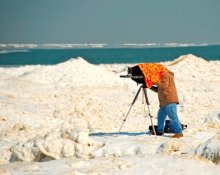Stephanie;
Congrats on the change: I hope that you enjoy it. Not everyone takes well to the more deliberate pace of using these large cameras but that big negative sure makes up for a lot! You're getting a lot of advice, some of it conflicting: that's all right. For most of the issues it's just like small format photography. There is rarely a "best" solution that's universal. One of the nice things about photography is that you can try any number of alternatives relatively cheaply, and discover what works best for you.
I second Steve Simmons' book on view cameras: easily the best introductory text I've found, especially on camera movements. I wish he'd update the equipment section, though: it's still useful but the specific examples are a little dated.
I've made several focusing cloths in my day, and I'm not all that handy with a sewing machine! The ones I've previously made were from some rather dense and opaque fabric, white on one side and black on the other and treated with one of those waterproofing sprays because some of the best light is in the middle of a rainstorm or snow storm! A touch on the heavy side, though, and sized for 4x5. Since I switched to 8x10 last year I wanted a larger cloth and my daughter sewed me a sweet one for my birthday: I told her that white was boring and I wanted something exciting, so she got some red and orange fabric which makes it look like I'm on fire, with some black fabric for the inner side. I think it looks rather... interesting (photo attached. It was taken this past February at the Lake Michigan lighthouse at St. Joseph, by Ray Ostrander.) Add a couple of the large size binder clips to your equipment bag, to clamp the thing to the back of your camera if there's a stiff breeze.
I've always developed film in trays, for two main reasons: first, it's dirt cheap and not being wealthy, savings on equipment mean more film and paper for me! Second, it scales very well: I can do from 1 to 8 sheets of 4x5 or 5x7 at a time (8 sheets is the capacity of my home-made film washer,) or 1 to 4 sheets of 8x10. If I have more film there's very little down time between batches. This is convenient for me and since it has been forever since I screwed up an important photograph this way, I see no need to spend money to do it differently. That wasn't the case in the beginning, though: there is some practice and care involved in not scratching the heck out of your film when you're first starting out. Edward Weston was the epitome of care in that case: as far as I've been able to determine, he processed one sheet of film at a time his entire life. Well, I just wish I were 1% of the photographer any of the Westons were.
My 4x5 enlarger is a Beseler 45 and it fits just fine into my (very) small darkroom in the basement. I use a Rodenstock 135mm enlarging lens with the tall condenser light source and don't hit the ceiling even on 16"x20" prints, which are frankly a little larger than my darkroom is comfortable with. A 4x5 enlarger shouldn't be very expensive, either.
Regarding the rest of the stuff, there was a darkroom advertisement locally on Craigslist this past week: a woman has stuff stored in boxes in a storage unit but can't remember what all she has (or at least, what was left after the last move.) I've gotten hold of her to go look at it but our schedules haven't met up yet. I'm hoping to get a nice box of darkroom staples and if I do I'll ship it to you. I'll keep trying to meet up with her through this weekend but if she keeps putting it off past then there's probably a reason, so don't get your hopes too high and certainly don't turn anything down waiting for this mess to clear!
One more piece of well-meant but probably useless advice: get a small piece of clear glass, like window glass, and try a few contact prints from your 4x5 negatives. For some reason I don't fathom (possibly because I'm not the world's best darkroom printer,) there's a difference between an enlargement and a contact print which is truely fascinating. Don't shut yourself out of that by thinking that 4x5 is too small to contact print: one of my most treasured possessions is a 4x5 cyanotype which daughter #2 got me for last year's birthday: it's just exquisite and I feel a little leap in my heart every time I see it.
Mike











